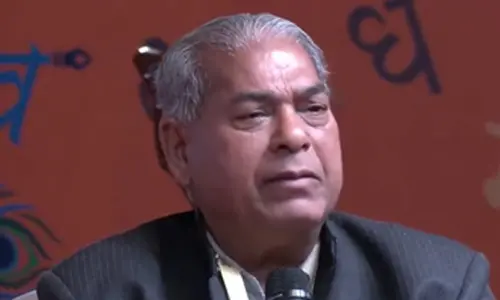Navratri 2024 Day 1: Colour, Puja Rituals, Auspicious Timings, and Bhog for Goddess Shailputri

Shardiya Navratri, a significant Hindu festival celebrating Goddess Durga, will begin on October 3, 2024, and continue until October 12.
Shardiya Navratri, a significant Hindu festival celebrating Goddess Durga, will begin on October 3, 2024, and continue until October 12. Observed in the month of Ashwin according to the Hindu calendar, this nine-day festival is marked by rituals, fasting, and cultural events. Devotees honour different forms of Goddess Durga throughout the festival, with Dussehra (Vijayadashami) on the tenth day symbolizing the triumph of good over evil.
Day 1 of Navratri: Honouring Goddess Shailputri
The first day of Shardiya Navratri is dedicated to Goddess Shailputri, marking the beginning of the festival and spiritual cleansing. Goddess Shailputri represents purity, strength, and stability, and worshipping her is believed to bless devotees with these qualities. The rituals on this day emphasize connecting with the Root Chakra and invoke a sense of community and devotion.
Colour of the Day: Yellow and Its Significance
Yellow is traditionally the colour associated with Day 1 of Navratri. It symbolizes joy, brightness, and an abundance of energy. Yellow is also connected to nature, growth, and fertility, aligning with the qualities of Goddess Shailputri, who embodies strength and purity. Each day of Navratri is associated with a different colour, representing the unique qualities of the goddess worshiped on that day.
Puja Rituals for Goddess Shailputri on Day 1
On the first day of Navratri, specific rituals are performed to honour Goddess Shailputri. Here is a step-by-step guide to the puja:
Preparation
Wake up early, bathe, and wear fresh clothes, preferably in yellow.
Clean the puja area thoroughly.
Kalash Installation (Ghatasthapana)
Fill a Kalash (pot) with water, coins, betel nut, and doob grass.
Arrange five mango leaves around the top of the Kalash and place a coconut over it.
Cover a raised platform with a red cloth and place an idol or picture of Goddess Shailputri on it.
Worship Process
Begin by praying to Lord Ganesha for the removal of any obstacles during the puja.
Offer jasmine flowers, incense, and kumkum to the goddess.
Light a lamp (diya) filled with ghee and place it beside the Kalash.
Chant the mantra “Om Hreem Kleem Shailputryai Namah.”
Perform the aarti and ring a bell to complete the worship.
After completing the aarti, offer bhog (food offerings) to the goddess as part of the concluding rituals.
Auspicious Timing (Shubh Muhurat) for Ghatasthapana on Day 1
The most auspicious time for Ghatasthapana on the first day of Navratri is during the Pratipada Tithi, which falls on the Abhijit Muhurat. For Navratri 2024, the Ghatasthapana muhurat is as follows:
Start Time: 6:15 AM
End Time: 7:22 AM
Abhijit Muhurat: 11:46 AM to 12:33 PM
Bhog Offerings for Goddess Shailputri
Offering bhog (food) to Goddess Shailputri on Day 1 of Navratri holds great significance. Here are some traditional offerings:
• Milk: Symbolizing purity, milk is considered a primary offering to the goddess.
• Honey: Representing sweetness, honey is offered to invoke a prosperous and joyful life.
• Ghee: Used in cooking and offerings, ghee symbolizes wealth and purity.
• Sugar: Offering sugar symbolizes sweetness and happiness in life.
• Seasonal Fruits: A variety of fresh fruits represent health and abundance.
• Coconut: Coconuts are often offered to symbolize success and prosperity.
• Sabudana Khichdi: A popular dish made with tapioca pearls, sabudana khichdi is consumed during fasting and offered as a pure food.
• Kalakand: This milk-based sweet is a common offering during festivals.
• Kheer: A sweet rice pudding made from milk and sugar, kheer symbolizes blessings of abundance and is offered to the goddess.
Navratri’s Day 1 rituals and celebrations foster a sense of unity and spiritual purification, with devotees coming together to honour the goddess and seek her blessings for a prosperous life.
















